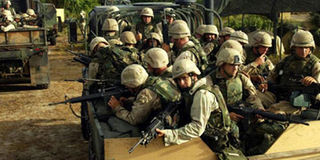US military opens up battle front lines to women

US marines leave their base in Manda Bay in Kenya. Come the New Year, the US military will open all fighting positions to women — but don't expect to see a female American commando leading a raid into Syria just yet. PHOTO | FILE
What you need to know:
- General David Perkins, who heads the US Army Training and Doctrine Command, this summer said military studies and a look at the experience of Canada, which has for years allowed women in combat, showed few women are likely to choose such roles.
- But not everyone agrees women should be in combat. The Marine Corps called for a partial exemption, after it argued mixed-gender combat units were less effective.
- "Female Marines who want to stir the pot by joining the infantry ranks are more interested in their careers than the needs of the Corps — they are selfish," Marine Captain Lauren Serrano wrote in the Marine Corps Times.
WASHINGTON
Come the New Year, the US military will open all fighting positions to women — but don't expect to see a female American commando leading a raid into Syria just yet.
Officials say it could take years for women to percolate into some of the military's most specialized roles, including the elite special operations forces that have long epitomized macho soldiering.
"Implementation won't happen overnight," Defense Secretary Ashton Carter said Thursday as he announced the Obama administration's "No Exceptions" policy unlocking every occupation in America's vast military.
Currently, women only account for about 15.6 percent of the 1.34 million active-duty personnel in the Army, Marine Corps, Navy and Air Force.
When the new rules kick in, 52 military occupations — some 220,000 jobs — will accept female applicants, who must still pass the same rigorous physical tests as men.
"For the 52 occupations that were completely closed, we have to start at the beginning," a senior defense official said.
"You have to recruit new recruits, they have to go to boot camp, they have to go to the (specialized) school."
For instance, it takes at least a year and a half to train a Navy SEAL before he (or she) can join a unit. Further training takes about another 12 months before deployment.
The Pentagon is increasingly relying on commandos to conduct raids in Iraq and Syria as America fights the Islamic State group.
SMALL GROUP
Another limiting factor is how many women actually want combat jobs.
General David Perkins, who heads the US Army Training and Doctrine Command, this summer said military studies and a look at the experience of Canada, which has for years allowed women in combat, showed few women are likely to choose such roles.
"It just probably won't be a lot," he said.
One reason is women are "dramatically less inclined" to choose infantry, armoured units or artillery than their male counterparts, he said.
In Canada, for instance, where women were permitted to join combat ranks as early as 1989, their numbers in those roles remain low — making up 0.5 percent of Canadian infantry, two percent of armored units and four percent of artillery, according to Perkins.
But Nancy Duff Campbell, co-president of the National Women's Law Center, said more women will eventually seek out combat roles.
"When women are given the chance, they seize it," she told AFP.
"It may be a small group at the beginning, but that group may be growing, like what we've seen in sports."
Aside from Canada, the US military follows in the footsteps of other fighting forces around the world allowing women in combat.
Among them are Australia, Denmark, Germany, Israel, the Netherlands, New Zealand, Norway, South Africa and Sweden.
A RAND Corporation study found women generally adapt well into combat positions — provided the top brass are committed and involved in the transition.
But not everyone agrees women should be in combat. The Marine Corps called for a partial exemption, after it argued mixed-gender combat units were less effective.
And a study obtained by the Defense One military news site found that SEALs, Air Force special operations forces and non-commissioned officers were still strongly opposed to women joining special operations ranks.
Some women have spoken out too.
"Female Marines who want to stir the pot by joining the infantry ranks are more interested in their careers than the needs of the Corps — they are selfish," Marine Captain Lauren Serrano wrote in the Marine Corps Times.
The new policy trumps such concerns, and Carter and other military officials stress that over time, women in combat will actually improve "combat effectiveness."
They point to other changes — such as letting gays serve openly — as disproving naysayer gloom.
EQUAL OBLIGATION
The changes could ultimately have far-reaching impacts for all young American women.
Though the US military has been an all-volunteer force since near the end of the Vietnam War, in 1973, all men aged 18-25 must nonetheless register for the draft in case there is a national crisis and re-institution of mandatory conscription.
But the National Coalition for Men — a San-Diego based rights group — argues the law is sexist because it refers specifically to "male persons" in stating who must register.
"Failing to register is a felony, but only for men, punishable by fine, imprisonment or both," the group's president Harry Crouch said.
The organization has a lawsuit that will be heard by a federal appeals court next week in California.
The suit had been tossed as not "ripe" but the group hopes Carter's announcement will convince the court to reconsider.
For women to be forced to register for the draft, Congress would have to change the law.
Duff Campbell of the National Women's Law Center agreed women should sign up for possible conscription.
"If we want women to have an equal opportunity to serve in all positions, they should have an equal obligation to register for the draft," she said.





